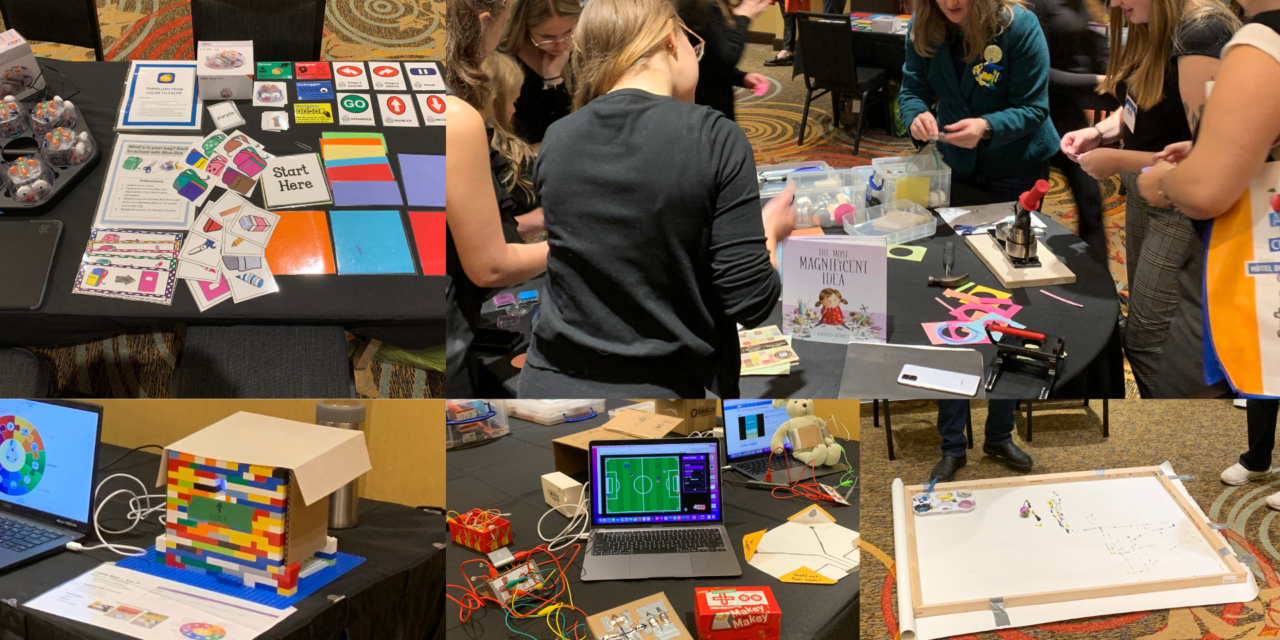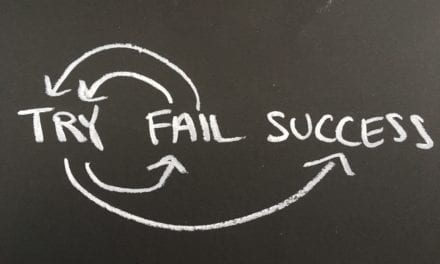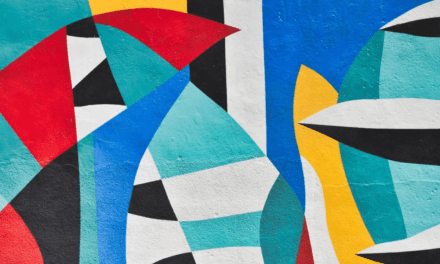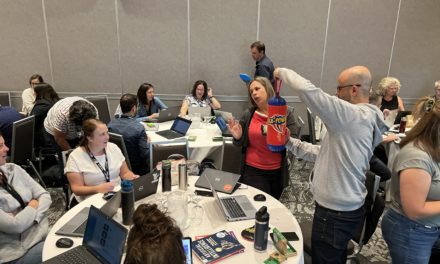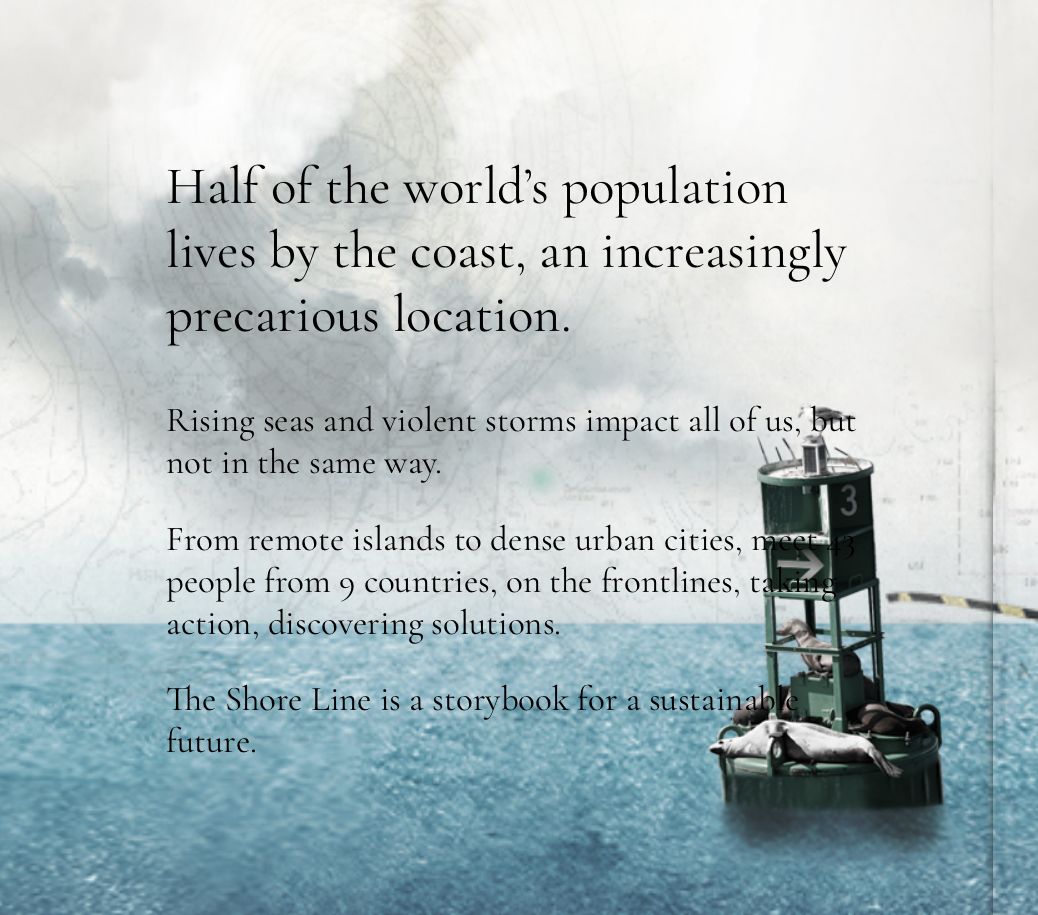Thomas Stenzel: In-person sessions
We have spent the past two years online in PD sessions that were often based on a speaker passing on information. On occasion breakout rooms might have been used to offer opportunities for discussion in small groups, however, there were many variables at play that influenced how well those went. Comfort, trust, and familiarity with the topic or with the other participants in a group, all seemed to be more acute issues when focused through a screen.
It has been my observation at conferences over the past six months that when opportunities arise for people to meet face-to-face during workshops or conferences, it is the conversations between participants that create the most energy whether in a session or in the hallways or at coffee breaks. Sessions that allow people to participate actively are better attended than those that are just presenting information, even if the topic is relevant and interesting.
In this digital age, there is an endless supply of recorded sessions that are available online for any topic you choose to research that you can watch and listen to and glean from at your own leisure and pace. When attending something online you can do other things if the session is not grabbing you, or you can just leave. This is much harder to do if you are in a live session that you registered for, traveled to, and are now sitting with others in a room with only one exit.
In discussions about how conferences are in this “post-covid” time, many colleagues have mentioned the added value of face-to-face time they themselves have experienced or have observed in other delegates at conferences. Within sessions, it was noted that when well-structured sessions provide focus and opportunity to co-construct the understanding of what is being presented or shared, participants were more engaged and had more ‘takeaways’.
Lexie Tucker: Opening Plenary
After 2 years of getting most of our entertainment through binge-watching shows on Netflix, I was eager to attend the QPAT Convention Keynote Speaker last Thursday night. While there is something to be said for watching shows while cuddled in your coziest pajamas,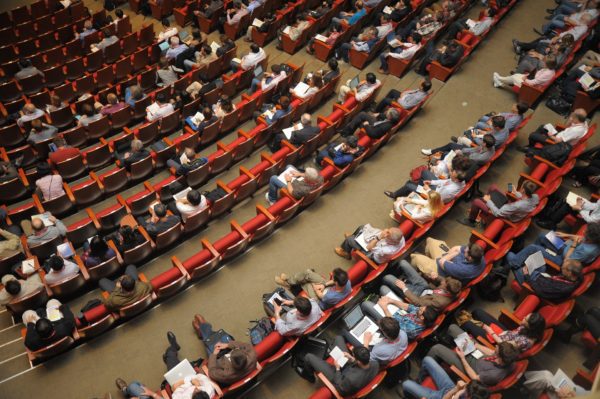 feeling the energy of a live audience heightens the viewing experience. It’s true what they say; laughter is contagious, and nowhere was that more true than watching Rick Mercer deliver his comedic perspective in person surrounded by hundreds of fellow educators.
feeling the energy of a live audience heightens the viewing experience. It’s true what they say; laughter is contagious, and nowhere was that more true than watching Rick Mercer deliver his comedic perspective in person surrounded by hundreds of fellow educators.
Mercer’s talk strayed from his usual political satire to focus more on personal reflection as he shared anecdotes and insights from his life. Mercer described his process for writing his most recent book, Talking to Canadians: A Memoir. Since writing a memoir was unfamiliar territory to Mercer, he did what many of us do when trying to do or learn something new; he googled it. Writing a memoir was one in a series of unknowns the comedian has embraced in his life.
Embrace what you don’t know. This was a theme of Mercer’s talk; he described several instances in his past when he agreed to opportunities even without fully understanding what he was getting himself into. Mercer stated he wouldn’t be where he is now if he had not been willing to embrace what he didn’t know. He also expressed gratitude towards his high school drama teacher who encouraged his creativity by pushing him to write a play.
Mercer finished his talk by saying that although he has spent the better part of his life thinking about what it means to be Canadian, he still doesn’t have an answer but that he is thankful to be one.
Sylwia Bielec: Spotlight on the Arts
After two years of online conferences and various PD sessions, the MAD2 DEEN committee for the Arts held an in-person Spotlight on the Arts. Last Spotlight was in 2019, so we were all very excited but also approached this 12th edition with some trepidation: would we see familiar faces? How many attendees would be at QPAT in person? How were people feeling these days, were they ok, or starting the year at the end of their rope?
We had decided to keep our familiar format of workshops, a round-table discussion and hands-on art-making for participants. We wanted to do something that we cannot really do online, and harness the in-person energy of the group, and its face-to-face contact.
Nicolas Doyon started off the day with a lively hands-on workshop on Shadow Theater, during which participants created a shadow box, made their own shadow puppets and wrote a scene or story. Using a lamp, they performed their shadow theater puppet show for an audience of participants and other Spotlight attendees. The workshop was 75 minutes long, and participants had an hour to work on their projects. It was amazing to see what they were able to do in an hour, as each group was able to complete a full production, which included not only narration or dialogue but also sound and visual effects. You can find Nic’s presentation here.

Zentangle pattern ideas
Without a doubt, the biggest success of this year’s Spotlight was the session by Samantha Abdallah titled Mindful Drawing: Art Therapy Meets Mindfulness. Based on our work with teachers (and let’s face it, our own lives), we had a feeling that self-care, wellness, and mindfulness were going to be high on people’s priority lists, both for themselves as professionals and also for their students. We know from our own experience the grounding aspect of the arts – whichever art you choose. Making art – whether it be drama, music, dance, or visual arts – ushers you into the present moment like little else. It was standing room only at the session, as over 45 participants drew, painted, traced, and remixed as Samantha Abdallah led them through a series of mindfulness exercises based on drawing. You can see Samantha’s presentation here.
We also held a round-table discussion, during which a handful of participants shared their experiences of the late-stage pandemic in the classroom. Teachers shared how they were organizing their classrooms now, and some lessons learned from when they were teaching online. One generalist spoke eloquently about the visible changes in her students when she engages them in making art, and how she would like to do so more often, even though she is not formally trained as an art teacher. The small 10-person group was able to have an in-depth sharing circle on their experiences, and connect with each other.
Craig Bullett: LEARN’s Open Creative Space
Our OCS gang also returned to a familiar QPAT conference format at the Bonaventure Hilton, and picked up where we left off back in 2019. Rather, we hoped for such a smooth return. The venue and the people were familiar, but much of the experience felt very new.
Back in 2019, we had achieved a certain momentum during our in-person professional development and content delivery. Participants were accustomed to interacting with resources in a free-flow manner while benefiting from best practices emerging from conversations with peers. At the time, the environment had an Open Creative Space feel to it where visitors could manipulate educational resources and create something in a short time, all while talking shop with other educators. In short, we were accustomed to our format and participants were equally comfortable navigating the physical space.
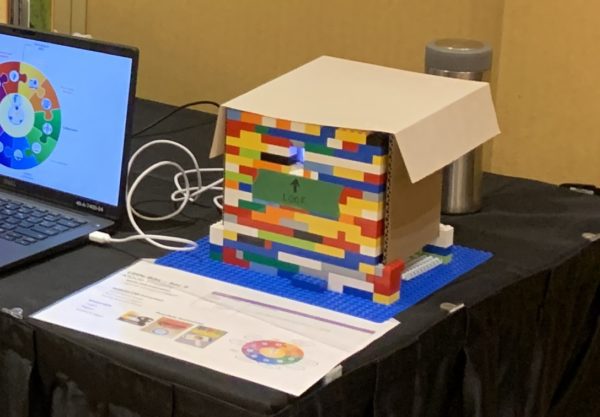
Movie Theater Project
Flash forward to 2022 and we recognize that professional development momentum has not fared well with the instability in education caused by the pandemic. During the almost 3 years of virtual professional development, we started to fall back to a stand-and-deliver model with more passive participation.
It is true that our schools now have a variety of robots, microcontrollers, and educational tech devices. The Digital Action Plan provided for this. Teachers may be superficially aware of new tech in their schools or see it being used by peers. However, some lack opportunities to fully explore these resources prior to being unleashed into the classroom. Our intention for the conference was paramount: Provide a space for educators to put their hands on resources and devices, make connections to fit tech into pedagogical situations (not the other way around!), then return to respective schools and confidently unbox the tech!
Despite the initial growing pains of animating our session this year, engagement did grow throughout the day. We hope to hear and see evidence of even more tech finding a pedagogical home in the classroom.
Tech, low-tech, and even some no-tech
Joining us for the day at the conference were local RECIT representatives from a couple of our English School Boards.
Anton Ryan from the New Frontiers School Board was onsite demonstrating Blue-Bots along with manipulatives and resources to connect computational thinking and coding to literacy and math concepts.
Monica Vassiliou from Riverside School Board was also in attendance to share how the design process could be used to make so many curriculum connections. The Riverside ‘Movie Theater Project’ was inspired by a High School Visual Arts teacher who incorporated robotics. The project employed a hands-on approach focused on animating an image much like a traditional flip book or stop-motion style app. There were so many STEAM connections here from students who made prototypes by assembling Little Bits and Lego, coordinating the speed of animation with the light source, and making it all hold together.
In one area of our OCS space , we had the Sphero robot to freestyle some artistic creations. We dipped the robot in paint (yes, you can do that!), programmed patterns and shapes for the robot to execute, and set the robot loose on the canvas.
Another table had some Makey Makey prototypes to play with. This station took the familiar banana piano a little further and expanded into STEAM connections with various materials. Participants experienced how voice recordings in language arts can come to life from circuits made with pencil drawings on paper. Game consoles made from cardboard, duct tape, and tin foil were also on display to play head-to-head soccer. There was even the possibility of making circuits to play a game of flappy birds in Scratch while actually flapping your arms to fly the bird in the game. More game ideas are available on the Makey plug-and-play APPs site and there are Scratch Studios dedicated to Makey projects.
Of course, the button-making station is always a hit wherever our OCS pop-ups find themselves. This is a low-tech option that still requires some problem-solving, troubleshooting, and creativity. Mastering the paper punch and Button die-set always adds to the challenge. Participants got to stretch the artistic envelope and especially enjoy an opportunity to chat with peers. Everyone left with an impressive souvenir for their efforts.
It was so nice to reconnect with all of you at the QPAT conference. We hope this blog post provides a trail of the creative space we brought to QPAT 2022, and that it encourages further exploration in your own classrooms. We look forward to seeing you at next year’s event.

